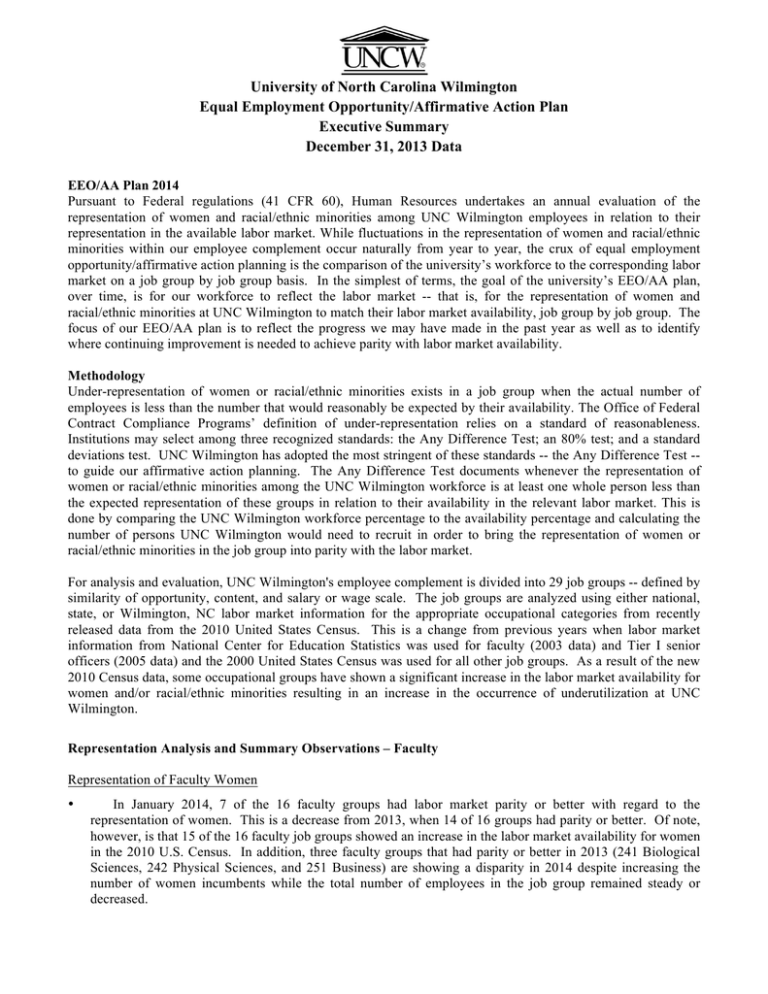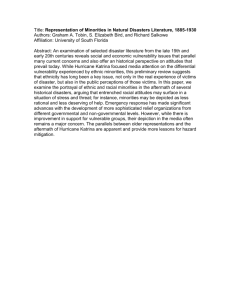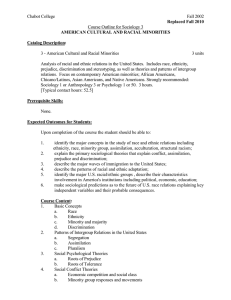Document 12072823
advertisement

University of North Carolina Wilmington Equal Employment Opportunity/Affirmative Action Plan Executive Summary December 31, 2013 Data EEO/AA Plan 2014 Pursuant to Federal regulations (41 CFR 60), Human Resources undertakes an annual evaluation of the representation of women and racial/ethnic minorities among UNC Wilmington employees in relation to their representation in the available labor market. While fluctuations in the representation of women and racial/ethnic minorities within our employee complement occur naturally from year to year, the crux of equal employment opportunity/affirmative action planning is the comparison of the university’s workforce to the corresponding labor market on a job group by job group basis. In the simplest of terms, the goal of the university’s EEO/AA plan, over time, is for our workforce to reflect the labor market -- that is, for the representation of women and racial/ethnic minorities at UNC Wilmington to match their labor market availability, job group by job group. The focus of our EEO/AA plan is to reflect the progress we may have made in the past year as well as to identify where continuing improvement is needed to achieve parity with labor market availability. Methodology Under-representation of women or racial/ethnic minorities exists in a job group when the actual number of employees is less than the number that would reasonably be expected by their availability. The Office of Federal Contract Compliance Programs’ definition of under-representation relies on a standard of reasonableness. Institutions may select among three recognized standards: the Any Difference Test; an 80% test; and a standard deviations test. UNC Wilmington has adopted the most stringent of these standards -- the Any Difference Test -to guide our affirmative action planning. The Any Difference Test documents whenever the representation of women or racial/ethnic minorities among the UNC Wilmington workforce is at least one whole person less than the expected representation of these groups in relation to their availability in the relevant labor market. This is done by comparing the UNC Wilmington workforce percentage to the availability percentage and calculating the number of persons UNC Wilmington would need to recruit in order to bring the representation of women or racial/ethnic minorities in the job group into parity with the labor market. For analysis and evaluation, UNC Wilmington's employee complement is divided into 29 job groups -- defined by similarity of opportunity, content, and salary or wage scale. The job groups are analyzed using either national, state, or Wilmington, NC labor market information for the appropriate occupational categories from recently released data from the 2010 United States Census. This is a change from previous years when labor market information from National Center for Education Statistics was used for faculty (2003 data) and Tier I senior officers (2005 data) and the 2000 United States Census was used for all other job groups. As a result of the new 2010 Census data, some occupational groups have shown a significant increase in the labor market availability for women and/or racial/ethnic minorities resulting in an increase in the occurrence of underutilization at UNC Wilmington. Representation Analysis and Summary Observations – Faculty Representation of Faculty Women • In January 2014, 7 of the 16 faculty groups had labor market parity or better with regard to the representation of women. This is a decrease from 2013, when 14 of 16 groups had parity or better. Of note, however, is that 15 of the 16 faculty job groups showed an increase in the labor market availability for women in the 2010 U.S. Census. In addition, three faculty groups that had parity or better in 2013 (241 Biological Sciences, 242 Physical Sciences, and 251 Business) are showing a disparity in 2014 despite increasing the number of women incumbents while the total number of employees in the job group remained steady or decreased. • A comparison of the labor market availability for faculty women to the percentage of incumbents showed that the percentage increased in 8 of 16 faculty groups, decreased in 5, and remained the same in 3 from January 2013 to January 2014. Representation of Faculty Racial/Ethnic Minorities • In January 2014, 5 of the 16 faculty groups had labor market parity or better with regard to the representation of racial/ethnic minorities. This is a decrease from 2013, when 8 of 16 faculty groups had parity or better. Of note, however, is that 14 of the 16 faculty job groups showed an increase in the labor market availability for racial/ethnic minorities in the 2010 U.S. Census. In addition, one faculty group that had parity in 2013 (261 Teaching Education) is showing a disparity in 2014 despite increasing the number of minority incumbents while the total number of employees in the job group decreased. • A comparison of the labor market availability for faculty racial/ethnic minorities to the percentage of incumbents showed that the percentage increased in 4 of 16 faculty groups, decreased in 10, and remained the same in 2 from January 2013 to January 2014. Overall As of January 1, 2014, UNC Wilmington had 1,839 employees, of whom 999 (54%) were women and 316 (17%) were racial/ethnic minorities, showing little change in the overall number of employees and representation of women and racial/ethnic minorities since January 1, 2013. In January 2014, 9 faculty groups and 7 staff groups reflected an under-representation of women and 11 faculty groups and 12 staff groups reflected an under-representation of racial/ethnic minorities. By comparison, in January 2013, 2 faculty groups and 4 staff groups reflected an under-representation of women and 7 faculty groups and 9 staff groups reflected an under-representation of racial/ethnic minorities. Seven Year Trend – All Employees For the past seven years, the overall percentage of women in relationship to the total number of employees has remained relatively stable. However, after a 2.7% increase to 20.3% in the percentage of racial/ethnic minorities in 2008, the percentage has since dropped by 3.1% to 17.2%. The total number of women and racial/ethnic minorities and the corresponding percentage of the total number of employees at UNC Wilmington, is illustrated in the following chart. UNC Wilmington Human Resources March 17, 2014 Page 2 of 5 Placement Goals By comparing the current year’s UNC Wilmington work force percentage and the labor market availability for both women and racial/ethnic minorities by job group, the university establishes a placement goal for job groups in which the work force (incumbency) percent is less than the labor market (availability) percent and the difference is at least one whole person. Two 2013 placement goals were met: Computer Science faculty women and Student Support women. Placement Goals for Women: Jan 2014 Labor Market Availability (GOAL) Jan 2014 Percentage of Women Incumbents Key: *New in 2014 =No Change from 2013 é Progress towards 2013 goal êDecrease from 2013 Difference (#) Expected minus Incumbents 211 Fine Arts Faculty 49.79% 35.48%* 8 221 English & Literature Faculty 58.67% 52.38%* 2 223 History Faculty 40.47% 34.78%* 1 232 Political Science Faculty 47.09% 25.00%* 3 233 Psychology Faculty 69.05% 50.00%* 6 241 Biological Sciences Faculty 47.81% 38.46%* 4 242 Physical Sciences Faculty 33.48% 27.42%* 3 251 Business Faculty 35.72% 31.82%* 2 261 Teacher Education Faculty 76.82% 63.77%é 9 H10 Senior Officers Tier I 58.55% 30.77%* 3 H11 Senior Officers Tier II 59.44% 52.00%é 3 H33 Instructional Support 60.83% 59.66%* 1 H34 Research Professional 46.88% 30.30%é 5 H42 Admin Paraprofessional 90.79% 88.32%* 3 H50 Office Support 96.27% 92.66%= 6 UNC Wilmington Human Resources March 17, 2014 Page 3 of 5 Placement Goals for Racial/Ethnic Minorities: Jan 2014 Labor Market Availability (GOAL) Jan 2014 Percentage of Minority Incumbents Key: *New in 2014 =No Change from 2013 é Progress towards 2013 goal êDecrease from 2013 211 Fine Arts Faculty 16.89% 8.06%é 221 English & Literature Faculty 16.11% 11.90%é 232 Political Science Faculty 25.68% 12.50%* 233 Psychology Faculty 21.13% 12.50%* 234 Sociology Faculty 21.23% 10.00%ê 241 Biological Sciences Faculty 24.14% 7.69%ê 242 Physical Sciences Faculty 18.60% 9.68%= 251 Business Faculty 25.19% 9.09%ê 261 Teaching Education Faculty 22.42% 18.84%* 272 Nursing Faculty 15.78% 9.09%* 273 Health Sciences Faculty 16.83% 6.67%ê H10 Senior Officers Tier I 23.51% 7.69%* H11 Senior Officers Tier II 23.91% 12.00%é H30 Administrative & Professional 25.07% 5.80%ê H31 Student Services 25.81% 17.36%é H32 Information Technology – Professional 29.84% 12.50%ê H33 Instructional Support 23.21% 15.13%é H34 Research Professional 26.87% 6.06%* H40 Technical Paraprofessional 28.40% 10.42%ê H41 Police and Safety 25.27% 8.00%= H42 Administrative Paraprofessional 22.35% 20.44%é UNC Wilmington Human Resources March 17, 2014 Difference (#) Expected minus Incumbents 5 1 2 2 6 8 5 10 2 2 3 2 6 26 10 16 9 6 8 8 2 Page 4 of 5 Jan 2014 Labor Market Availability (GOAL) Jan 2014 Percentage of Minority Incumbents Difference (#) Expected minus Incumbents Key: *New in 2014 =No Change from 2013 é Progress towards 2013 goal êDecrease from 2013 H50 Office Support 20.90% 15.25%* H60 Skilled Crafts and Trades 23.59% 8.22%ê 10 11 UNC Wilmington Human Resources March 17, 2014 Page 5 of 5






